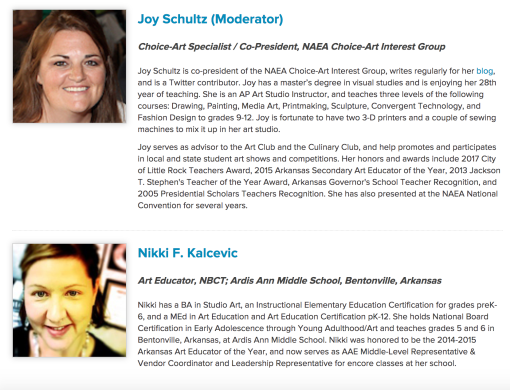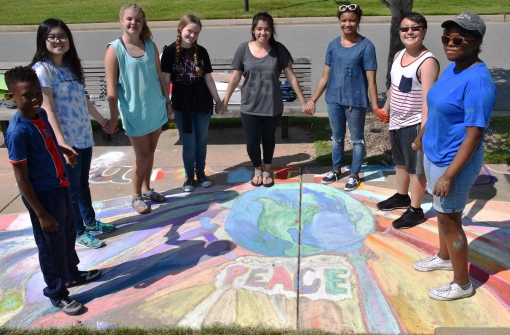
I just completed a Statewide tour of Arkansas. I was able to travel all over to areas I didn’t know and visit arts buildings to see the programs they offered the community. I spent several nights in hotels and one magical night in a Bed and Breakfast. I traveled with a talented artist from Arkansas who has an eclectic life story that matches her layered and fascinating art work. It was a fantastic experience and we matched up perfectly.
I have attended loads of PD in my almost 30 years of education. I have presented at local conferences and at the National convention for years, but this was personal.
The professional development program was created by the Arkansas Education Department and it connects working local artists with art educators, to bring professional development for visual arts. This an opportunity to engage with a local arts programs and become informed about the artist registry.
Jeri Hillis was the talented artist I was matched with for the workshop. After doing research on her, I figured that her work in collage was going to be our focus for the art making. http://www.arkansasarts.org/artist-registry/jeri-hillis
Collage is a wonderful approach to introduce the methods of teaching how ChoiceArt is implemented into a studio classroom. I was able to show how I implement ChoiceArt in my studio and I was also able to demonstrate to the educators how to figure out the methods that would best fit them as the facilitator plus meet the demographics of their school population, and how to explain the ChoiceArt methods to all the stake-holders. I also wanted my participants to get back in touch with the inner artist, and level up skills/techniques, and open their minds to my teaching practice. I designed the professional development program to try to bring out the working artist in each participant with the focus on Appropriation and Collage. It is very important to NOT jump right in but really think about how to implement this in your program. Think about how you would educate the population in the school district. Also, how to educate others on what ChoiceArt teaching practice will bring to the educational program.
ChoiceArt FB page https://www.facebook.com/groups/1699665476977044/?ref=br_rs
My presentation included the way I figured out a work flow, method of implementation, how to leverage my student learning management platform, my grading process, and how to communicate to everyone. This has been a program developed over time. I stressed that this is how it works for my school and for my personality. I know myself well and I know my school community well. It took a lot of front-end loading to get to where I am. People can see and hear what I do but ultimately, the educator needs to customize the practice to suit the situation. If I would move to a new school and teach a different population, I would need to make adjustments.
I had several participants at the workshop who were not visual arts educators and they came to learn about how students present their process and how to cultivate individual voices. I feel they were able to collect ideas from how I also stress the importance of building community by verbal critiques, how to implement classroom mentors, how to engage students to present their ideas in progress, and showcase the portfolio the students created for documenting the process for final critiques. In addition,how to use artist proposals and written reflections as a key to developing a voice that leads to a solid artist statement.
My goal was to educate and get educators back in touch with how they feel when creating, how they organize thoughts and materials, and how their individual pace in thinking/progress happens. We often feel pressure of our daily schedule, expectations for evaluations, and the curricular requirements. I wanted to remind the educators about how the most important part of what we do is visual communication. How do we support our students where they start and meet their individual needs? Where to do we leave room for thinking, practicing, experimenting, inventing, etc.? This is all learning and it happens during the process.
IF the student is engaged the end product will speak for itself.

Art educators are often under-appreciated for how well we juggle the materials, behaviors, studio space, and nurturing the soul of our students. In our studio’s the space needs to be a community that is safe for everyone. All students deserve a safe place to explore, learn, grow, fail, and succeed. Succeed based on what the student has identified as success not by the appearance of the product. The learning is an intrinsic value. This is often invisible accept when there is time and a method to communicate the learning. We need to continue to create methods to make the learning and the success from the process, visible beyond the finished product.
We need to meet our students where they are when they enter our space. It is nearly impossible to meet the needs of everyone when we don’t even consider a student-centered approach. I am not going to have everyone or even a handful of students become famous successful artists.
I will have all of my students aware of their visual communication skills, how to figure out their work flow, apply the techniques and vocabulary they explored, be in touch and aware of artists worldwide, blend seamlessly the other academic areas they love into the visual communication created in the studio. I will have young people who understand the importance of the “WHY” when creating original works of art. I will have students that are confident recording their thoughts, ideas, progress, failures, research, and the confidence to speak and assist others. I will have students who see the visual arts as a powerful tool to communicate effectively in the world with the balance of understanding how to wield that power on social media. Plus, have an understanding of the damage that can be done to oneself for not comprehensively planning what they share on social media. Leveraging visual communication is powerful but it needs to be taught how to be effective.

I communicated at the workshop that I feel that I am always perfecting my teaching practice and my studio is my lab. It is my goal to be an effective practitioner of Visual Communication and this requires reflection and data points. I utilize Google Forms and other digital platforms to gather and analyze how effective I am doing in my attempts. Through my Google Forms and my student learning management platforms, I am able to collect information to adjust my practice. I am also able to communicate with my individual students easily and to offer input and additional research, support, and plan scaffolding to increase student success. This is work but with digital tools it makes it easier.
Wow! Didn’t think I’s write so much. I guess my reflecting on my experience helped me clarify my own voice. Funny…. I preach that all the time. Again, practice what you preach.
So, glad I did this summer PD. Looking forward to not driving and staying in hotels for a while. I need some deep immersion into my own art before beginning my storage room clean out at school.




 Wow!
Wow!























Recent Comments